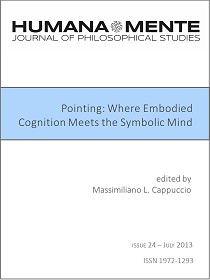Evidence and Interpretation in Great Ape Gestural Communication
Abstract
Tomasello and colleagues have offered various arguments to explain why apes find the comprehension of pointing difficult. They have argued that: (i) apes fail to understand communicative intentions; (ii) they fail to understand informative, cooperative communication, and (iii) they fail to track the common ground that pointing comprehension requires. In the course of a review of the literature on apes’ production and comprehension of pointing, I reject (i) and (ii), and offer a qualified defence of (iii). Drawing on work on expressive communication, I sketch an account of a mechanism by which ape gestural communication may proceed: the showing of expressive and naturally meaningful embodied behaviours. Such gestures are easily interpretable because they present rich evidence for a speaker’s message. By contrast, pointing typically provides poor evidence for a speaker’s message, which must therefore be inferred from considerations in the interlocutors’ common ground. This makes pointing comprehension comparatively difficult.
Copyright (c) 2013 the author

This work is licensed under a Creative Commons Attribution-NonCommercial-NoDerivatives 4.0 International License.




